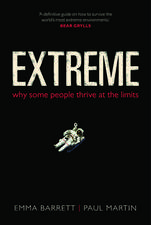Human Behavior in the Social Environment from an African-American Perspective: Second Edition
Autor Letha A Seeen Limba Engleză Paperback – 2 aug 2007
Human Behavior in the Social Environment from an African-American Perspective, Second Edition acquaints practitioners with the Black experience, and provides the latest innovative methods of working with this diverse population. This edition also offers new insights on evaluating practice initiatives. Experts and scholars explore and interpret individual and group behaviors, the strength and resilience of the black family, the stresses and problems affecting children, the significant problem of the affects of colorism, the self-esteem and identity issues of biracial children, violence in the criminal justice system, the HIV/AIDS pandemic, the stress and behaviors resulting from belonging to the armed services, and other behavior stemming from progression through the life cycle. Chapters include charts and tables of data, extensive references, and study questions for deeper study for students.
Topics in Human Behavior in the Social Environment from an African-American Perspective, Second Edition include:
- the importance of the consideration of the black experience in analyzing black behavior
- behavior as a response to a hostile social system
- the black church’s role in leading African-Americans
- resiliency perspective as a positive force
- the use of strength behaviors for socialization and survival
- strategies to strengthen roles of fathers in African-American families
- military culture as a microcosm of the wider society
- the psychological effects of skin color on self-esteem
- the No Child Left Behind Act of 2001 and its effects
- refreshing social work practice to better meet the needs of African-American girls
- examination of a study on the help-seeking behaviors of young African-American males
- empirically based creative intervention strategies to alleviate black-on-black crime
- analysis of street gang behaviors with a program to address it
- influences of hip hop culture
- strategies to lessen substance abuse in children
- practices that help assist administrators and social workers to lessen school violence
| Toate formatele și edițiile | Preț | Express |
|---|---|---|
| Paperback (1) | 522.19 lei 43-57 zile | |
| Taylor & Francis – 2 aug 2007 | 522.19 lei 43-57 zile | |
| Hardback (1) | 1640.70 lei 43-57 zile | |
| Taylor & Francis – 2 aug 2007 | 1640.70 lei 43-57 zile |
Preț: 522.19 lei
Preț vechi: 549.66 lei
-5% Nou
Puncte Express: 783
Preț estimativ în valută:
99.92€ • 104.61$ • 82.68£
99.92€ • 104.61$ • 82.68£
Carte tipărită la comandă
Livrare economică 07-21 aprilie
Preluare comenzi: 021 569.72.76
Specificații
ISBN-13: 9780789028327
ISBN-10: 0789028328
Pagini: 828
Ilustrații: 1, black & white illustrations
Dimensiuni: 152 x 229 x 38 mm
Greutate: 1.1 kg
Ediția:Revizuită
Editura: Taylor & Francis
Colecția Routledge
Locul publicării:Oxford, United Kingdom
ISBN-10: 0789028328
Pagini: 828
Ilustrații: 1, black & white illustrations
Dimensiuni: 152 x 229 x 38 mm
Greutate: 1.1 kg
Ediția:Revizuită
Editura: Taylor & Francis
Colecția Routledge
Locul publicării:Oxford, United Kingdom
Cuprins
- About the Editor
- Contributors
- Foreword (Joycelyn Elders)
- Preface to the First Edition
- Preface to the Second Edition
- Acknowledgments
- PART I: THE CONNECTION BETWEEN BEHAVIOR, ENVIRONMENT, AND THE AFRICAN-AMERICAN EXPERIENCE
- Chapter 1. Introduction: Human Behavior Therapy and the African-American Experience (Letha A. [Lee] See)
- Chapter 2. African Americans’ Response to Their Social Environment: A Macro Perspective (Tony B. Lowe and June Gary Hopps)
- PART II: UNDERSTANDING BLACK FAMILIES
- Chapter 3. The Black Family in the Twenty-First Century and the Church As an Action System: A Macro Perspective (Andrew Billingsley and Barbara Morrison Rodriguez)
- Chapter 4. Enhancing the Resilience of African-American Families (Robert B. Hill)
- Chapter 5. Strength Behaviors for African-American Socialization and Survival (Jerome H. Schiele)
- Chapter 6. Family Roles of Noncustodial African-American Fathers (Robert B. Hill)
- Chapter 7. African-American Military Service Members and Their Families: A Different Environment (Jesse J. Harris and Norma G. [Cindy] Jones)
- PART III: THE FORMATIVE YEARS OF BLACK CHILDREN
- Chapter 8. The Psychological Effects of Skin Color on African Americans’ Self-Esteem (Letha A. [Lee] See and Rufus Larkin)
- Chapter 9. An Examination of the Self-Esteem and Self-Identity of Biracial Children in the United States (Naomi T. Ward and Alieizoria Redd)
- Chapter 10. No Child Left Behind: Can African Americans Break the Profound Cycle of Apathy and Will Social Workers Help? (June Gary Hopps, Tony B. Lowe, Robbie C. Tourse, and Alice Boateng-Cooper)
- PART IV: THE TEEN YEARS
- Chapter 11. Revisiting the Regendering of Social Work Practice with African-American Girls (Linwood H. Cousins and Tracey Mabrey)
- Chapter 12. African-American Adolescent Girls: Facing the Challenges and Consequences of Violence in the Inner City (Annie Woodley Brown and Ruby M. Gourdine)
- Chapter 13. The Empowerment of Young African-American Males: Implications for Social Work Practice (Cudore L. Snell and Julie Guyot)
- Chapter 14. Prevalence and Incidence of Black-on-Black Crime Among Youth (Tiffany D. Bauffour)
- Chapter 15. Black-on-Black Crime: Compensation for Idiomatic Purposelessness (Revisited) (Rufus Larkin and Creigs C. Beverly)
- Chapter 16. African-American and Other Street Gangs: A Quest for Identity (Revisited) (Jerome L. Blakemore, Yolanda Q. Mayo, and Glenda M. Blakemore)
- Chapter 17. Hip Hop Culture: An Alternative Site for Gender Socialization in the African-American Community (William Oliver)
- Chapter 18. Substance Abuse Among African-American Children: Contemporary Issues and Challenges for Effective Intervention (Darlene Grant and Barbara W. White)
- Chapter 19. Continuing the Fight Against School Violence: Progress, Current Practices, and Future Directions (Revisited) (Edgar H. Tyson, Freddie L. Avant, and Robert O. Washington)
- PART V: YOUNG AFRICAN-AMERICAN ADULTS
- Chapter 20. Violence in Prison Systems: An African-American Tragedy (Jerry G. Johnson)
- Chapter 21. African-American Women with HIV/AIDS (Larry Williams and Rufus Larkin)
- Chapter 22. Deconstructing the “Down Low”: An Ecological Perspective on African-American Men Who Have Sex with Men (MSM) (Dorie J. Gilbert and Larry Williams)
- Chapter 23. Stressors Experienced by African-American Armed Service Personnel During the Iraqi War (Tony B. Lowe, June Gary Hopps, and Letha A. [Lee] See)
- Chapter 24. Educational Resilience Among African-American College Students Who Have Experienced Long-Term Foster Care (Sherri F. Seyfried, Judith Birgen, and Kimberly A. Mann)
- PART VI: BEHAVIORS DURING THE MIDDLE YEARS AND OLD AGE
- Chapter 25. The Impact of Racism, Poverty, Educational Attainment, and Masculine Identity on the Efficacy of African-American Fatherhood (Janice Matthews Rasheed and Ron Stewart)
Descriere
Human Behavior in the Social Environment from an African-American Perspective, Second Edition is an updating of the classic text that presents leading black scholars discussing complex human behavior problems faced by African-Americans in today's society. This new edition provides fresh theories and the latest practical interventions, and includes a new foreword by former Surgeon General, Dr. Joycelyn Elders.










